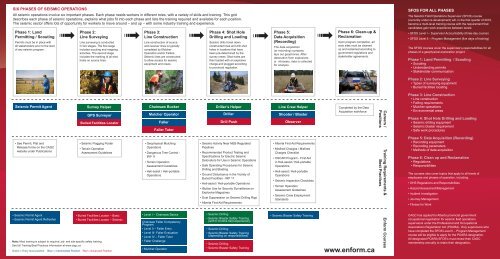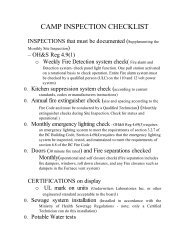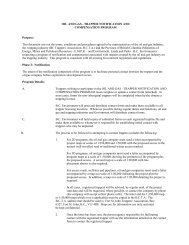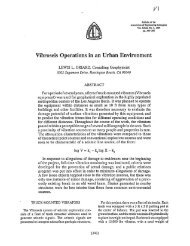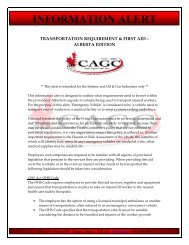seismic field operations, safety and training - Canadian Association ...
seismic field operations, safety and training - Canadian Association ...
seismic field operations, safety and training - Canadian Association ...
Create successful ePaper yourself
Turn your PDF publications into a flip-book with our unique Google optimized e-Paper software.
SIX PHASES OF SEISMIC OPERATIONSAll <strong>seismic</strong> <strong>operations</strong> involve six important phases. Each phase needs workers in different roles, with a variety of skills <strong>and</strong> <strong>training</strong>. This griddescribes each phase of <strong>seismic</strong> <strong>operations</strong>, explains what jobs fi t into each phase <strong>and</strong> lists the <strong>training</strong> required <strong>and</strong> available for each position.The <strong>seismic</strong> sector offers lots of opportunity for workers to move around – <strong>and</strong> up – with some industry <strong>training</strong> <strong>and</strong> experience.Phase 1: L<strong>and</strong>Permitting / ScoutingPermits must be in place withall stakeholders prior to the startof any <strong>seismic</strong> program.Phase 2:Line SurveyingLine surveying is conductedin two stages. The fi rst stageincludes scouting <strong>and</strong> mappingactivities. The second stageincludes the marking of all shotholes on source lines.Phase 3:Line ConstructionLine construction of source<strong>and</strong> receiver lines is typicallycompleted by MulcherOperators <strong>and</strong>/or Fallers.Seismic lines are constructedto allow access for <strong>seismic</strong>equipment <strong>and</strong> crews.Phase 4: Shot HoleDrilling <strong>and</strong> LoadingSeismic drills travel downconstructed lines <strong>and</strong> drill shotholes in locations that havebeen pre-determined by thesurvey crews. Shot holes arethen loaded with an explosivecharge <strong>and</strong> plugged accordingto provincial regulation.Phase 5:Data Acquisition(Recording)The data acquisition(or recording) companylays out geophones. Afterdetonation from explosivesor vibroseis, data is collectedfor analysis.Phase 6: Clean-up &ReclamationUpon program completion, allwork sites must be cleanedup <strong>and</strong> reclaimed according togovernment regulations <strong>and</strong>stakeholder agreements.SFOS FOR ALL PHASESThe Seismic Field Operations Supervisor (SFOS) course(currently under re-development) will, in the fi rst quarter of 2010,become a multi-level <strong>training</strong> course with the requirement thatc<strong>and</strong>idates gain work experience between levels:• SFOS Level I – Supervisor Accountability (three-day course)• SFOS Level II – Program Management (fi ve days of <strong>training</strong>)The SFOS courses cover the supervisor’s responsibilities for allphases of a geophysical exploration project.Phase 1: L<strong>and</strong> Permitting / Scouting• Scouting• Underst<strong>and</strong>ing permits• Stakeholder communicationPhase 2: Line Surveying• Types of surveying equipment• Buried facilities locatingSeismic Permit AgentSurvey HelperGPS SurveyorBuried Facilities LocatorChainsaw BuckerMulcher OperatorFallerFaller TutorDriller’s HelperDrillerDrill PushLine Crew HelperShooter / BlasterObserverCompleted by the DataAcquisition workforceCareers /PositionsPhase 3: Line Construction• Line construction• Falling requirements• Mulcher <strong>operations</strong>• Environmental areasPhase 4: Shot Hole Drilling <strong>and</strong> Loading• Seismic drilling equipment• Seismic blaster requirement• Safe work procedures• See Permit, Plat <strong>and</strong>Release forms on the CAGCwebsite under Publications• Seismic Flagging Poster• Terrain OperationAssessment Guidelines• Geophysical MulchingOperations• Dangerous Tree Control -IRP 11• Terrain OperationAssessment Guidelines• Heli-assist / Heli-portableOperations• Seismic Activity Near NEB RegulatedPipelines• Recommended Product Testing <strong>and</strong>Specifi cations for Electric SeismicDetonators for Use in Seismic Operations• Safe Operating Procedures for SeismicDrilling <strong>and</strong> Blasting• Ground Disturbance in the Vicinity ofBuried Facilities - IRP 17• Heli-assist / Heli-portable Operations• iButton Use for Security Surveillance onExplosive Magazines• Dust Suppression on Seismic Drilling Rigs• Alberta First Aid Requirements• Alberta First Aid Requirements• Misfi red Charges / Misfi redCharges Checklist• OSCAR Program - First Aidin Heli-assist / Heli-portableOperations• Heli-assist / Heli-portableOperations• Seismic Inspection Checklists• Terrain OperationAssessment Guidelines• Seismic Crew EmploymentSt<strong>and</strong>ardsTraining Requirements &Best PracticesPhase 5: Data Acquisition (Recording)• Recording equipment• Recording parameters• Methods of data acquisitionPhase 6: Clean up <strong>and</strong> Reclamation• Regulations• ResponsibilitiesThe courses also cover topics that apply to all levels ofemployees <strong>and</strong> phases of operation, including:• OHS Regulations <strong>and</strong> Responsibilities• Hazard Assessment/Management• Incident Investigation• Journey Management• Fitness for Work• Seismic Permit Agent• Seismic Permit Agent Refresher• Buried Facilities Locator – Basic• Buried Facilities Locator – SeismicNote: Most <strong>training</strong> is subject to required, job- <strong>and</strong> site-specifi c <strong>safety</strong> <strong>training</strong>.See full Training Best Practices information at www.cagc.ca.Green = Entry level positionBlue = Intermediate Position Red = Advanced Position• Level I – Chainsaw BasicsChainsaw Faller CompetencyProgram• Level II – Faller Entry• Level III- Faller Evaluation• Level IV – Faller Tutor• Faller Challenge• Mulcher Operator• Seismic Drilling• Seismic Blaster Safety Training(with 6 months fi eld experience)• Seismic Drilling• Seismic Blaster Safety Training(depending on responsibilities)• Seismic Drilling• Seismic Blaster Safety Training• Seismic Blaster Safety Trainingwww.enform.caEnform CoursesCAGC has applied for Alberta provincial governmentoccupational registration for <strong>seismic</strong> <strong>field</strong> <strong>operations</strong>supervisors under the Professional <strong>and</strong> Occupational<strong>Association</strong>s Registration Act (POARA). Only supervisors whohave completed the SFOS Level II – Program Managementcourse will be eligible to apply for the POARA designation.All designated POARA SFOS’s must renew their CAGCmembership annually to retain their designation.


